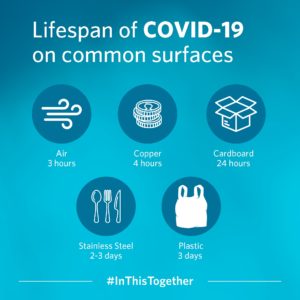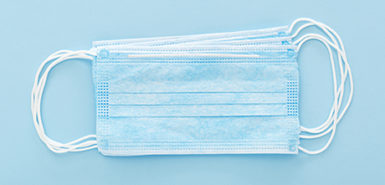
Workers in the health care, grocery and transportation industries have emerged as essential heroes in this quicksilver COVID-19 timeline.
The rest of us? If we’re dialed into the health guidelines, we’re planted firmly at home.
But at some point, you’ll need to replenish your dwindling grocery supply.
Larger retailers let you order groceries online and pick them up curbside. Some offer delivery, although there are sometimes wait times. There are also home deliveries from Shipt and Instacart. Restaurant takeout and fast food remain viable options.
Using such services will substantially lower your exposure to others, which isn’t a bad thing these days—especially for older people and those with compromised immune systems.
In-store shopping presents various challenges, but can be done by following basic precautions to reduce your risk.
Your personal tolerance for risk will largely dictate how you shop and how you handle purchased goods.
The essential acts
COVID-19 spreads in two primary ways.
First: contamination by inhalation of respiratory droplets from an infected individual.
This “typically requires close proximity, as these droplets tend to settle out of the air onto surrounding surfaces,” said Adam Caulfield, PhD, director of microbiology with Spectrum Health.
This has led to physical distancing guidelines recommending a distance of 6 feet from others and staying at home as much as possible.
The second primary route of infection: contact with contaminated surfaces, followed by touching your eyes, nose or mouth.
“While disinfecting surfaces should be considered, hand-washing and an intentional awareness about touching your face are the most important,” Dr. Caulfield said.
Retailers have stepped up their cleaning game in recent weeks, some trimming store hours so workers can restock shelves and sanitize.
For your part, take precautions the moment you enter a store.
“While shopping, you should be aware of the surfaces you touch,” Dr. Caulfield said. “Consider wiping down high-touch surfaces like the handle of your shopping cart. And avoid crowded areas when possible.”
Virus survivability

Research indicates particles of COVID-19 can remain airborne for three hours in perfect conditions.
“It’s important to realize that the virus is rapidly disintegrating from the moment it’s released by an infected individual through sneezing or coughing,” Dr. Caulfield said. “Unlike bacteria, viruses cannot replicate in the environment—and every couple of hours, the amount of viable virus is reduced by half.”
On surfaces, COVID-19 can survive at least three days on plastic, two days on stainless steel, one day on cardboard and four hours on copper, according to a recent report The New England Journal of Medicine.
Applied to shopping, you’ll have to be sensible about handling food and packages.
Produce
Produce out in the open, such as apples and peaches? Shop as though someone else touched it.
Some folks will pick up an avocado to feel it if it’s ripe enough, then put it back down.
“How many people are doing that?” said Jessica Corwin, a Spectrum Health dietitian. “There may be potential for contamination upon delivering the produce and setting it out, in addition to multiple shoppers picking it up to check it out.
“Each touchpoint, depending on the timeframe, may increase risk,” she said. “Try to limit your own touchpoints in the produce section.”
Need to test ripeness? “Please make sure your hands are clean—or consider wearing gloves,” Corwin said.
When you return home, thoroughly wash all produce—melons, lemons, avocados.
“Even with those, we are supposed to wash the skin,” she said. “When you cut it with your knife, the germs on the outside, you’re going to drag those through the flesh of that avocado or melon.”
It’s sound advice under any circumstance.
“The things you normally do, you should be more diligent about safety,” she said.
Dr. Caulfield is a big believer in scrubbing veggies and fruit.
“All fresh produce should be carefully washed with soap and water prior to eating,” he said.
The Food and Drug Administration has extensive guidelines on produce safety amid COVID-19.
There’s really no final word on how to best wash produce. Some use running water and scrub vigorously, some use soap and water. The LA Times has a great article on strategies.
Packaged goods
Currently, the Centers for Disease Control and Prevention has taken the stance there is low risk of spreading COVID-19 on food products and packaging shipped over a period of days or weeks at ambient temperature, or even frozen or refrigerated.
The more likely route of transmission is person-to-person, via close contact.
But in the grocery store, there are plenty of people out shopping—touching, handling, doing their people thing.
If you’re highly concerned about exposure to COVID-19, you could get downright scrupulous.
Family medicine specialist Jeffrey VanWingen, MD, posted a step-by-step YouTube video of precautions he takes, such as unpackaging boxed items and disposing of original packages, or repackaging them into clean containers.
He shops for his parents, who are in the demographic at high risk during this pandemic.
“Desperate times call for desperate measures,” Dr. VanWingen said. “These are unprecedented times.”
His precautions are time-consuming indeed, but as he points out, “These days, in truth, people do have a bit more time on their hands.”
He advises, for example, leaving non-perishable groceries in the car or garage for three days. If you can’t wait that period, he shows how to disinfect and separate each item.
Dr. Caulfield said he’s heard of folks leaving grocery orders and online orders in the garage for a day or so before bringing them into the house.
He said while there’s no harm in this, “I do not personally sanitize food packages after grocery shopping, due to the negligible risk.”

 /a>
/a>
 /a>
/a>
 /a>
/a>
My concern is that if people go through the arduous process of sanitizing every item, or
even removing items from their original packaging, they may fall into a false sense of security and forget to do the most important step – washing their hands – before they eat or begin preparing food.
You’re right, Shana, that everyone needs to remember to wash their hands for at least 20 seconds with soap and water. Often. There is no substitute for good hand-washing. 🙂
Very informative and gave me a few answers I’ve been looking for!
Sincerely thanks!
You’re most welcome, Jerry. Best wishes to you and yours during this time.